— It is out of step with the continent’s values, many bishops say, and threatens to derail expansion in the church’s fastest growing region in the world.
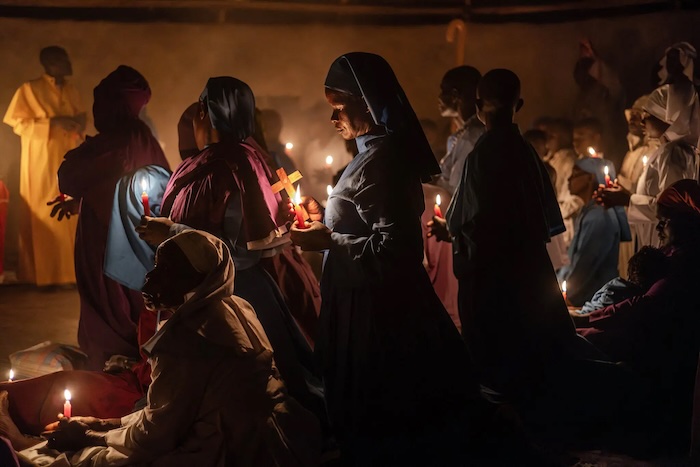
by
The Vatican’s recent declaration allowing the blessing of same-sex couples caused a stir around the globe, but perhaps most of all in Africa, a rising center of the Roman Catholic Church’s future. In one statement after the next, bishops in several countries spoke of the fear and confusion the declaration has caused among their flocks, and said it was out of step with the continent’s culture and values.
The bishops also harbored a deeper fear: that in a place where the church is growing faster than anywhere else in the world, and where many forms of Christianity are competing for worshipers, the declaration could slow the church’s expansion on the continent.
Bishop John Oballa of the Ngong Diocese near Nairobi said that a woman had written to him saying that a friend told her he wanted clarification on the declaration, or else he would convert to the Methodist Church.
“There’s a lot of vibrancy in many, many dioceses of Africa,” Bishop Oballa said in an interview. “We need to safeguard against anything that might derail that growth.”
He said he would advise his priests to give blessings to same-sex couples only if they were seeking God’s strength in helping “to stop living in same-sex unions.”
But if the couple merely wanted a blessing and planned to continue living the way they were, “it may give the impression of recognition,” he said, adding that he would advise clergy “not to bless because it may be scandalous to others — it may weaken the faith of others.”
This past week, the Vatican sought to placate those bishops alarmed by the new rule, saying that allowances should be made for “local culture,” but that it would remain church policy. Bishops opposed to the change, it said in a statement, should take an “extended period of pastoral reflection” to wrap their heads around why the Vatican says the blessing of same-sex couples is in keeping with church teaching.
Home to 236 million of the world’s 1.3 billion Catholics, Africa accounted for more than half of the 16.2 million people who joined the church worldwide in 2021. As bishops and other church leaders on the continent deal with the fallout among their parishioners over the declaration, broader concerns have been raised about whether it could lead to a rift between Pope Francis and a region that is a demographic bright spot for Catholicism.
“I think there is a rebellion already that’s started to say, ‘We’re not going implement this,’” said Father Russell Pollitt, the director of the Jesuit Institute South Africa, referring to the responses of bishops across the continent.

Some African clergy said they expected the Vatican and church leaders in Africa to work through their differences. But the declaration has complicated the relationship and will force difficult conversations between the church’s central authority and its African leaders. Some bishops have even hinted at a split between the values of African nations and the West, where some clergy had for years been running afoul of the Vatican’s guidance by blessing same-sex unions.
“In our African context, while recognizing the confusion existing in the more developed countries of new, unchristian models of ‘conjugal union’ and ‘styles of life,’ we are very clear on what a family and marriage is,” said a statement from the Kenya Conference of Catholic Bishops.
Without exception, church leaders in Africa have emphasized to their flocks that the declaration approved by Francis was explicit in saying that marriage remained a union between a man and a woman. They have stressed that the church’s doctrine on marriage has not changed, and that the declaration is about blessing the individuals, not their relationships.
Bishops in Malawi and Zambia have already said that, to avoid confusion, their clergy would be instructed not to give blessings to same-sex couples. The Catholic Bishops Conference of Nigeria did not take a firm position on the issue, and said in a statement that “asking for God’s blessing is not dependent on how good one is.” But it added that there was “no possibility in the church of blessing same-sex unions and activities,” a nod to the declaration’s nuance of blessing gay individuals not relationships.

The Southern African Catholic Bishops’ Conference affirmed that distinction in its statement. But it went further in saying that the church’s position was that “all people, regardless of their sexual orientation, must be treated with the dignity that they deserve as God’s children, made to feel welcome in the church, and not be discriminated against or harmed.”
The Vatican’s declaration has laid bare a tension for the church in Africa: How can it welcome homosexuals while not upsetting believers who stand firmly behind the church’s teaching that homosexuality is a sin?
Some African church leaders feel strongly that they should not even talk about homosexuality “because it is un-African,” said Bishop Sithembele Sipuka of the Mthatha Diocese in South Africa, who is also the president of the Southern African conference. Others, he added, felt differently because they personally knew gay people. “It is not our experience that it’s this thing they got from Europe,” he said.
His conference has interpreted the declaration to mean that people in same-sex relationships can be blessed, he said, but individually and not presented together.
Months before the Vatican’s declaration, Bishop Martin Mtumbuka of the Karonga Diocese in Malawi delivered a fiery sermon accusing Western pastors of trying to bend the word of God to accept homosexuals as a way of attracting a larger pool of priests and other religious vocations.
“Any one of us pastors who champions this is just being heretical and fooling himself,” Bishop Mtumbuka said, according to an audio recording of the sermon, which circulated widely on social media after the Vatican’s declaration.

Francisco Maoza, 48, a parishioner who lives in Malawi’s capital, Lilongwe, said he was relieved when his country’s bishops said they would not permit blessings for same-sex couples.
“I still think the position by the pope is wrong,” said Mr. Maoza, a carpenter. “In the African context, even in Malawian culture, we don’t allow men and women to marry people of their own sex. So why should priests be allowed to bless such unions?”
Another Catholic in Malawi, Josephine Chinawa, said she felt that Francis needed to step down because of the declaration.
“I really couldn’t understand his motivation,” she said. “Maybe he is too old.”
However, Father Pollitt said that some church leaders in Africa were being hypocritical. While they severely criticize homosexuality, he said, they say little about other “irregular unions” identified in the Vatican’s declaration, such as unmarried heterosexual couples who live together. The document says that priests can bless them, too. There have also been many cases on the continent of priests breaking celibacy rules by having children, but that does not get the same scrutiny among church leaders, he said.
“Let’s face facts: There is a lot of homophobia in Africa,” Father Pollitt said.
How the controversy over the blessing of same-sex couples plays out in the long run in Africa remains an open question. Some analysts say there may end up being very little tension, primarily because few gay couples are expected to actually ask for blessings.
“I don’t think they would even have the courage to introduce their partners to their parents, let alone coming to receive a blessing from the priest,” Bishop Oballa said.
Bishop Sipuka said that the Vatican and African church leaders would eventually find a way forward.
“I foresee a softening of position, maybe, by some who have reacted very strongly, as the document gets explained and discussed,” he said.

Complete Article ↪HERE↩!
The Pope’s Coming Vatican Showdown with American Conservatives
— Francis’s recent journeys ahead of the October synod may be signals about the future direction of the Church.
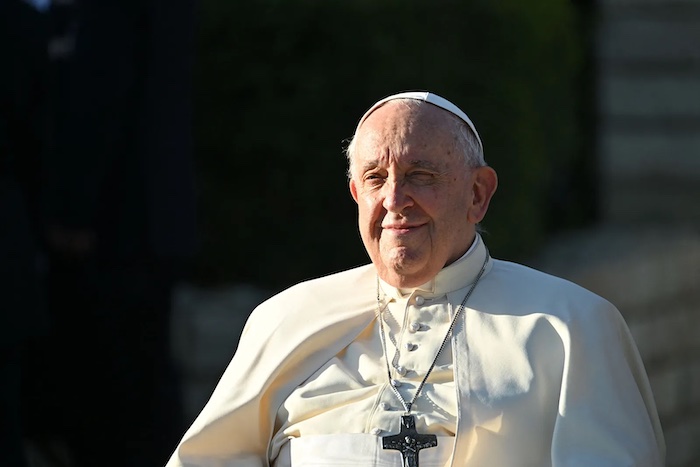
By
Pope Francis’s “apostolic journey” to Mongolia earlier this month had the unexpected consequence of bringing Pierre Teilhard de Chardin, a singular and controversial French Jesuit scientist who died nearly seventy years ago, into the news cycle. As it turns out, Teilhard’s theology of cosmic spiritual progress is a useful way to understand the challenges that Francis is currently facing, as he and the Church prepare for a global synod next month in Rome. There, three hundred and sixty-three clerical and lay leaders representing two rival conceptions of the Church will encounter one another for several weeks of behind-closed-doors dialogue—a process that is meant to be amicable but may lead to open conflict prior to a second session next October.
The main question surrounding the Pope’s journey was “Why Mongolia?” The country, with a population of around 3.3 million, has only fifteen hundred Catholics, fewer than in a large parish in Chicago—and far fewer than in other Asian nations, such as Vietnam, which has seven million Catholics and a complex history with the Church, and may have benefited from a papal visit. (By comparison, in early August, Francis celebrated Mass in Lisbon for a million and a half congregants, many of them young people there for World Youth Day.)
But the trip suited Francis’s stated wish for the Church to go “to the margins,” and allowed him to spend time with Giorgio Marengo, an Italian cleric who has lived for more than two decades in Mongolia, doing missionary work, such as fostering Catholic-Buddhist dialogue. In August of last year, Francis made Marengo, who is forty-nine, the youngest member of the College of Cardinals, where he is likely to be a progressive presence for decades to come. And being in Mongolia gave Francis an opportunity to direct remarks, implicitly, to the neighboring powers: Russia, whose war in Ukraine has occasioned a shifting and at times confusing response from him; and China, where the Vatican’s agreement to let the government choose which priests become bishops, in exchange for tolerating the Church’s presence in that nation, has been widely criticized.
The trip also expressed Francis’s own long-distance interest in Asia. As a young man in Argentina, he wanted to be a missionary in Japan; then and afterward, he hoped to follow in the footsteps of influential Jesuits who spent large parts of their careers in Asia: St. Francis Xavier, Matteo Ricci, Pedro Arrupe, and Teilhard de Chardin. Born in France in 1881, Teilhard was a restless, searching figure: a priest, a poet, a stretcher-bearer in the First World War, a paleontologist based in China (where, in the nineteen-twenties, he took part in an important expedition in search of human origins), and a mystical theologian. His written work, a sustained effort to reconcile Christian theology with the theory of evolution, placed him in the vanguard of twentieth-century theology—though lately otherwise appreciative theologians have expressed concern that his emphasis on progress through evolution led him to contrast “the advancing wing of humanity” with “definitively unprogressive ethnical groups,” thus aligning himself with movements in support of race-based eugenics. Teilhard’s notion that the earth would someday be surrounded by a complex information system powered by human consciousness has been seen as anticipating the Internet, and the Episcopal homilist at Prince Harry’s wedding to Meghan Markle, in 2018, alluded to one of Teilhard’s aphorisms: “Someday, after mastering the winds, the waves, the tides, and gravity, we shall harness for God the energies of love, and then, for a second time in the history of the world, man will have discovered fire.” But Teilhard’s most memorable concept is the notion that “tout ce qui monte, converge,” or “everything that rises must converge”—that the various forces of natural evolution and human civilization are all ascending in a pattern of spiritual progress and will converge in a “Point Omega” at the end of time.
While doing field work in Mongolia, in 1923, Teilhard celebrated what he called a Mass on the World; lacking bread and wine to consecrate in the usual fashion, he simply consecrated the whole physical world, represented by the vast steppe where he stood. The Mass was expressive of Teilhard’s thought, which, in 1927 and afterward, drew the attention of the Vatican, where officials objected to his dismissal of the idea that the human race descended from Adam and Eve, and his corresponding lack of emphasis on the idea of original sin.
During the next three decades, Teilhard elaborated on his outlook in a number of essays and two books, “The Divine Milieu” and “The Phenomenon of Man.” The Vatican and his Jesuit superiors forbade him to publish any theological writing, but he remained a faithful Catholic and an obedient Jesuit. Following a visit to the U.S. in 1948, he settled in a Jesuit residence in New York City, where he died in 1955, on Easter Sunday—and the posthumous publication of his work began. During the Second Vatican Council, which first convened in 1962, criticism of his work eased, and his books became standard texts for progressive theologians—until they fell out of favor again, under the traditionalist Popes John Paul II and Benedict XVI, even as they personally spoke warmly of him from time to time.
This Pope, however, has looked emphatically to Teilhard as an example. In “Laudato Si,” his landmark encyclical on the climate, from 2015—he is expected to issue another one next month—he cited Teilhard as an inspiration. After celebrating Sunday Mass in Mongolia, Francis spoke ardently about Teilhard, on the centenary of the Mass that he celebrated there. “This priest, often misunderstood,” he said, “intuited that ‘the Eucharist is always in some way celebrated on the altar of the world.’ ” The Pope was bringing the priest back from the margins, and joining his own Asian journey to Teilhard’s.
Francis’s trademark style of discourse is to issue an offhand comment that is clearly on the side of progress, but to remain vague about how progress is to be achieved, and this tendency, too, has lately sparked controversy. Following a video call with young Russian Catholics, on August 25th, in which Francis urged them to connect with their roots in the “Great Russia of saints, rulers, Great Russia of Peter I, Catherine II, that empire—great, enlightened, of great culture and great humanity,” Archbishop Sviatoslav Shevchuk, the head of the Ukrainian Greek Catholic Church, immediately castigated the Pope for celebrating Russian imperialism past and present. Then the Jesuit journal La Civiltà Cattolica published a transcript of a conversation that Francis had with Portuguese Jesuits during his trip earlier that month. When one asked about the open criticism of him by some American Catholics, including bishops, Francis replied at length. “You have seen that in the United States the situation is not easy: there is a very strong reactionary attitude. It is organized and shapes the way people belong, even emotionally,” he said. “I would like to remind those people that indietrismo”—backwardness—“is useless, and we need to understand that there is an appropriate evolution in the understanding of matters of faith.” He later added, “Those American groups you talk about, so closed, are isolating themselves. Instead of living by doctrine, by the true doctrine that always develops and bears fruit, they live by ideologies.”
Which American groups, everyone wanted to know, was Francis talking about? In the Times, C. Preston Noell III, of the American Society for the Defense of Tradition, Family, and Property (a Pennsylvania-based offshoot of a Brazilian group founded in 1960 to resist supposed communist influence on the Church), pointed out that Francis has spent less than a week in the United States as Pope, suggesting that he is poorly informed about the life of the Church here. The Washington Post ran a dossier of suspects, among them Raymond Arroyo, a host on the traditionalist Catholic cable network EWTN, based in Alabama, who has personified the network’s opposition to Francis. Others pointed to Cardinal Raymond Burke, who served as the archbishop of St. Louis and then as a Vatican official, until he was removed from one post in 2014 and replaced in a different one earlier this year. In the foreword to a new book, Burke writes that the October synod will cause “confusion and error” and lead to “the grave harm of many souls.” The book has been published in eight languages by the Society for the Defense of Tradition, Family, and Property, which has sent copies to bishops and clergy, some of whom will be delegates to the synod.
Complete Article ↪HERE↩!
Notre Dame Invites Gay Priest For ‘Queer Holiness’ Event
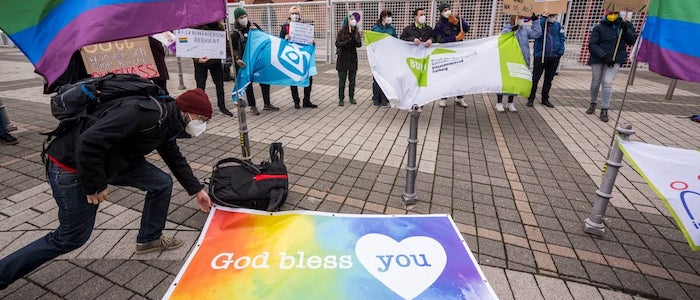
The University of Notre Dame is hosting a “Queer Holiness” event next week to discuss “Experiential Christian Anthropology,” according to the event page.
On March 23, the university’s John J. Reilly Center is hosting a “Queer Holiness” event with Rev. Dr. Charlie Bell to address the church’s “hostile questions” regarding the LGBTQ community. Bell, a gay deacon in the Church of England and a Cambridge fellow, is also the author of the book “Queer Holiness,” which claims to “find a better way to do theology – not about, but with and of LGBTQI people.”
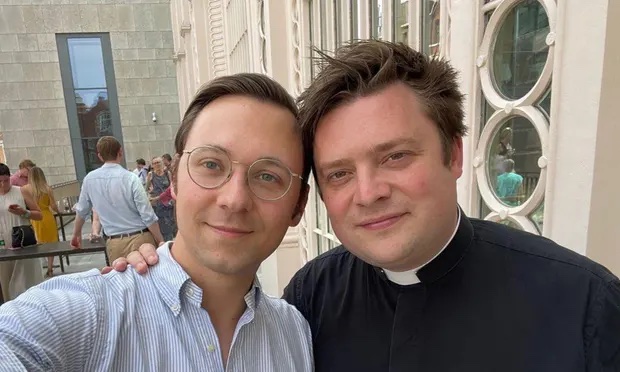
“From prohibitions on who they might love or marry, to erasure and denial, the theological record is one in which LGBTQI people are far too often objectified and their lives seen as the property of others,” the book’s summary read. “In no other significant religious question are ‘theological’ arguments made that so clearly reject overwhelming scientific and experiential knowledge about the human person. This book seeks to find a better way to do theology – not about, but with and of LGBTQI people – taking insights from the sciences and personal narratives as it seeks to answer the question: ‘What does human flourishing look like?’”
The event is being sponsored by the Center for Spirituality at Saint Mary’s College alongside Notre Dame, according to the event page.
“For millennia institutional churches have told LGBTQI people what God expects them to be and how to act,” the event’s flyer read. “In parts of the church, LGBTQI people remain the subject of hostile questions rather than being embraced as equal children of God. Charlie Bell’s … thesis is simple—to reject the overwhelming scientific and experiential knowledge about LGBTQI people is no longer valid.”
The university says that its mission is “defined by its Catholic character,” but Bell’s event appears to contradict several recent comments by Pope Francis. In January, the pope said that homosexuality, while not a crime, was a sin and most recently called “gender ideology” one of the “most dangerous ideological colonizations.”
Notre Dame made waves earlier this month when it was revealed that the Catholic university invited a transgender abortion doula to speak for the school’s “Reproductive Justice” series.
Notre Dame, JJRC, CS and Bell did not immediately respond to the Daily Caller News Foundation’s request for comment.
Complete Article ↪HERE↩!
The Deep Strangeness of the Catholic Church’s Latest Scandal
The outing of a top administrator of the nation’s conference of Catholic bishops as a regular Grindr user was clearly a story. But what kind?

Once, it was said that the eyes were the windows to the soul. Now the cellphone is. Consider Jeffrey Burrill, a man who regularly logged in to the gay dating app Grindr and whose cellphone emitted signals marking his visits to gay bars and a Las Vegas gay bathhouse. Hardly a story there, you might say.
Except Jeffrey Burrill was Monsignor Jeffrey Burrill, the secretary-general of the United States Conference of Catholic Bishops. And his July 20 resignation was forced by a newly founded Catholic online newsletter using commercially available data to trace his calls, movements, and behavior since 2018.
The outing of a top administrator of the nation’s conference of Catholic bishops was clearly a story. But what kind? A story about high-tech surveillance and invasion of privacy? About a new breach of journalistic ethics? About the Catholic Church?
Much of the national attention to this unusual episode focused on privacy issues. The basic problem is not complicated. In principle, data from mobile devices are “anonymized” by substituting a unique numerical identifier for users’ names and phone numbers. But mobile-phone location information and app usage is often recorded. A sufficiently interested party, with some additional information about residences, workplaces, and other data points, can connect the dots (or in this case the pings) to tie specific devices to specific individuals, such as Burrill.
“There’s not much to stop similar spying on politicians, celebrities and just about anyone that’s a target of another person’s curiosity—or malice,” Maggie Gile noted in Newsweek. Senator Ron Wyden, an Oregon Democrat, recalls years of warnings that data harvested from phones could be used to track their users and “reveal the most personal details of their lives.” A “vast and largely unregulated” industry assured the public that the information it collected was anonymous, he says. “As this awful episode demonstrates, those claims were bogus.”
The difficulty of safeguarding privacy from invasive technology cries out for remedies. But as a journalist and a Catholic (who has covered and written extensively about religion), I am even more interested in the other two stories, about journalistic ethics and about the Catholic Church.
I can reasonably be ranked among those labeled liberal Catholics. I am on record arguing that the Church should thoroughly rethink its teachings on sexuality, including contraception, same-sex relationships, and priestly celibacy. But I have little patience for the thankfully few dismissals of Burrill’s “indiscretions” on the grounds that “we are all sinners.” We are indeed all sinners, but we are not all secretaries-general of the United States Conference of Catholic bishops. Those of us who make solemn promises, whether of priestly celibacy or marital fidelity, should keep them. All the more so when our vows bear directly on our public roles.
If Burrill was in fact regularly violating his public commitment and leading a double life, it does not pain me that he was forced from office. What does pain me is how that came about, setting, as it does, dangerous precedents for both journalism and Catholicism.
The Pillar, the online newsletter that outed Burrill, was founded last January by J. D. Flynn and Ed Condon, two Catholic crusaders for a purer Church. Its founding statement promised to uphold “the highest standards of journalistic independence and craftsmanship.” The newsletter’s reporting on Burrill, though, has prompted questions about whether it has lived up to that mission.
The Pillar story acknowledged that the data it had obtained contained “no evidence to suggest that Burrill was in contact with minors.” But from the opening paragraph, the story missed no opportunity to mention the Church’s sex-abuse scandal, charges that Grindr and other “hookup apps” are used to facilitate sex with minors, and unrelated cases here and abroad of such criminal behavior by priests. Responding to protests that the exposé dwelled on a homophobic stereotype of gay predators, Flynn and Condon went on Twitter the day after it was published to repeat that no evidence linked Burrill’s use of gay dating apps to minors, and that they had had no intention to “insinuate” otherwise. Fair enough, if you don’t consider devoting more than 1,100 words of a 2,900-word article to that kind of linkage an insinuation.
Criticism of The Pillar’s journalism did not end with complaints about its use of innuendo. The newsletter’s resort to an ethically disturbing, even if legal, high-tech method to expose private behavior was also clouded by unanswered questions. In their lengthy exposé, Flynn and Condon went into detail about how the hookup app’s signals indicated Burrill’s systematic violation of his vow of celibacy. But they were vague about the source of this data. “The data obtained and analyzed by The Pillar,” they wrote, “was obtained from a data vendor and authenticated by an independent data consulting firm contracted by The Pillar.”
Who was the data vendor? Were the data purchased or volunteered? How were they analyzed to pinpoint a particular individual? And who funded this possibly expensive process? To critics of The Pillar’s journalism, these are key questions. Relying on anonymous sources is legitimate, and sometimes necessary. But good journalism requires giving readers some indication of the reason for anonymity and what it might suggest about the source’s perspective or motives.
Questions about the data source are underlined by another article, published at 3 a.m. on July 19—one day before The Pillar’s July 20 exposé—by the Catholic News Agency (CNA), a similarly conservative outlet where Flynn and Condon had previously worked. Written by Alejandro Bermudez, the agency’s executive director, the story said that in 2018, CNA had been approached by someone claiming “to have access to technology capable of identifying clergy and others who download popular ‘hook-up’ apps.” The person’s aim, Bermudez wrote, was to save the Church from clergy engaged in scandalous conduct. Recognizing the potential for blackmail in such data, however, the source wanted to keep them from falling “into the wrong hands.” Bermudez met with the person, who named “high-profile Catholic personalities” that the technology identified. Nonetheless, Bermudez said, he distrusted the offer and turned it down.
This is a tantalizing story, and I phoned Bermudez about it. “Chatter” from friends, he told me, about a coming revelation of online activities by major Church figures had brought to mind the 2018 offer and moved him to rush out his account. “It was important for us to say as a news organization that from a Catholic journalists’ standpoint this was a dangerous door to open.” The 2018 offer, he explained, was not only for a “whole package” but for an ongoing relationship with a steady flow of information from the source. This was hardly an ordinary offer, I noted. Was it believable, as his story claimed, that Bermudez couldn’t recall the name of the person who made it and never mentioned it to Flynn, who was CNA’s editor in chief at the time? Bermudez did not budge from his previous explanation that “crazy” accusations against Church leaders were so commonplace that they were not a matter of conversation. Avoiding any mention of The Pillar, he was simply adamant about rejecting, in 2018 and today, this way to reform the Church.
In view of the CNA story, one naturally wonders whether its unnamed source is the same person who was anonymously peddling a pre-targeted and tailored data set, indeed a working relationship, in 2018. The Pillar won’t say. (I emailed the publication to ask for comment, but received no reply.)
There is another eyebrow-raising aspect of The Pillar’s successful identification of a single individual from a data set that might have begun with billions of signals from millions of users: It’s costly. It may require a team of researchers. Not everyone agrees, but several technical experts have estimated the cost at hundreds of thousands of dollars. One data expert, Zach Edwards, the founder of an analytics firm, even said millions.
This story has opened an entirely new, scorched-earth stage of the decades-long conflict between Catholic conservatives and liberals that began after the 1962–65 Second Vatican Council, simmered for decades, and has broken into civil war since the election of Pope Francis in 2013. The issues at stake in this struggle include changes in the liturgy authorized by the Council, questions about sexual morality that the Council never considered, and the relationship between the papacy and bishops around the globe. Should the priesthood continue to be open only to celibate males? What priority should the Church give to issues of personal, especially sexual, morality compared with those of social justice?
These debates are not new. But what was once jousting among theologians, intellectuals, and papal authorities, as the laity silently aligned themselves with one side or the other, has become a battle between Pope Francis and a phalanx of high-ranking bishops. In August 2018, the retired Vatican diplomat (and onetime Vatican ambassador to the U.S.) Archbishop Carlo Viganò even demanded that Francis resign.
When Flynn and Condon, both trained as canon lawyers—specialists in Church law—started The Pillar in January, they declared that the newsletter would be “independent of any ecclesial agenda but the holiness of the Church.” Yet their take on “the holiness of the Church” implies a definite “ecclesial agenda,” on which few concerns rank higher than sexual morality, at least as I read it. To Flynn and Condon, a major threat to that holiness is tolerance of homosexuality and homosexual conduct, particularly among the clergy and bishops.
For decades, Catholic ultraconservatives have charged that the Church’s American hierarchy was being manipulated by a gay cabal. The same note has been sounded by Archbishop Viganò, who extends this charge to include Vatican circles. In a different register, it has been sounded by gay advocates, including gay priests and ex-priests, who argue that the hidden lives compelled by the Church’s strictures against same-sex relations are responsible for grave pathologies among the clergy. Even some advocates of a married (heterosexual) priesthood have echoed something similar: The requirement of celibacy has made the Catholic priesthood a refuge for many gay men who have not come to terms with their sexuality.
For The Pillar, Burrill was no one-off. It had already taken its data set to the archdiocese of Newark, headed by Cardinal Joseph Tobin, a strong supporter of Pope Francis, and to the Vatican itself. The Pillar claimed that signals from both homosexual and heterosexual hookup apps going back to 2018 could be traced to “more than 10” Newark rectories and clerical residences, including “several” with a frequency indicating use by residents. (The Newark archdiocese has 212 parishes.) As for the Vatican, The Pillar reported that over six months in 2018, at least 32 mobile devices emitted signals from dating apps, including Grindr, within areas of Vatican City not accessible to the public. By The Pillar’s standards and my own very traditional ones, all these hookup efforts in Newark and Rome were regrettable, but whether their numbers should be considered extensive or whether they came from clergy or lay employees, the newsletter did not say.
One wonders if the bishops conference, like so many corporations confronting charges of sexual impropriety, might not enlist an independent investigator to shed light on the whole episode. Who, for example, promoted and vetted Burrill for his post? How did his quite extensive double life escape notice? It is an unnoted irony that Burrill was ordained in the diocese of La Crosse, Wisconsin, when its bishop was Raymond L. Burke, today an archbishop, a leading opponent to Pope Francis, and an outspoken advocate of Church teachings on homosexuality, divorce, and abortion. Nothing in Burrill’s subsequent career steps marked him as anything but a conventional doctrinal conservative.
Questions about Burrill are only the starting point. What are the implications for Catholicism if the traditional surveillance of theological ideas and pastoral practice by Church authorities is replaced by the high-tech surveillance of moral failings by freelance journalists? The implications for journalism and personal privacy are serious. Even the person peddling the surveillance technology back in 2018 recognized its potential for blackmail. Without either strong professional censure or legal regulation, tech-savvy and scoop-hungry reporters on the brawling frontiers of online journalism are likely to make this kind of personally invasive technology part of their tool kit. A thoroughgoing inquiry and report could be a service well beyond the Church.
Defenders of The Pillar’s actions have shrugged off these concerns about privacy, journalism, and the Church. Stephen P. White, of Catholic University and the Ethics and Public Policy Center, dismissed those “ticked off” by The Pillar’s reporting—including “data-security gurus, would-be gatekeepers of the journalistic guild,” and “the usual voices on Catholic social media who cry ‘homophobia’ every time it is suggested that an unnatural vice among clerics might be a problem worth addressing.” The real problem was that “ecclesially minded journalists like Flynn and Condon” were being treated as “pariahs” for exposing “inconvenient truths about clerical sins.” In the defenders’ confidence that no ominous red lines are being crossed here, they seem to be forgetting one fundamental component of the Catholic teaching to which The Pillar pledged itself at its founding: Original Sin.
Complete Article ↪HERE↩!
Italy is debating an LGBT anti-hate law.
The Vatican just took a rare step to protest it.

By Chico Harlan and Stefano Pitrelli
The Vatican has taken a highly unusual step against its neighbor, sending a diplomatic note to the Italian government that protests a draft law aimed at preventing hate and violence against LGBT people.
The complaint marks a formal effort by the Vatican to influence Italian lawmaking and could provide a test for how forcefully the church can exercise its clout on culture war issues — not just as a religion but as a state.
While it’s common for church figures to take stances on affairs in other countries — whether on same-sex marriage, LGBT rights or abortion — in this case the Vatican is invoking its prerogatives as a nation, arguing that the law, if passed, would violate the “concordat” that provides the framework for its relationship with Italy.
“Some current contents of the draft being debated by the Senate reduce the freedom granted to the Catholic Church,” the Vatican’s note said, according to the Corriere della Sera newspaper, which first reported the letter.
The Vatican’s press office confirmed that the city-state sent a note to the Italian ambassador to the Holy See last week but did not provide more details. Benedetto Della Vedova, an Italian foreign ministry undersecretary who has read the document, called the message “heavy interference” and said the Vatican city-state had not previously attempted to influence the Italian government on highly contentious issues such as abortion and divorce.
“The effects of this escalation aren’t positive for anyone,” Della Vedova said. He declined to share a copy of the letter with The Washington Post, but he described the core of the Vatican’s contention — that the draft law would violate specific aspects of the concordat dealing with religious freedom and freedom of expression. The Vatican’s goal is to have the draft bill amended.
The law, known as the Zan bill, after gay activist lawmaker Alessandro Zan, was approved last year by Italy’s lower house and has since been under debate in the Senate, amid fierce national discussion. The bill would explicitly categorize violence against LGBT people as a hate crime, making it akin to racial or antisemitic attacks, while establishing harsher penalties than those currently on the books.
Members of far-right political parties have said the legislation would suppress opinion. The leader of the far-right League, Matteo Salvini, said it would punish those “who think a mom is a mom and a dad is a dad.”
Advocates say that the law would merely put Italy in line with other Western European countries and provide belated safeguards after a series of murders and assaults targeting transgender people. According to Rainbow Europe, an LGBT association, Italy provides some of the weakest legal protections on the continent for LGBT people.
The explanation for that is based partly on the Catholic Church’s deep historical influence on Italy. When Italy was first considering granting legal rights to same-sex couples, the powerful Italian bishops’ conference sponsored protests, and Pope Benedict XVI helped lead a campaign to stop it. (When Italy approved civil unions in 2016, Pope Francis took a more hands-off approach.)
But even though Francis has at times signaled a more welcoming church stance on homosexuality, the church has not shifted its official teachings and laws. In March, the Vatican made explicit its position that priests cannot bless same-sex marriages. The church has also taken a clear stance on gender issues and said in 2019 that people do not have the right to choose their own gender.
The Zan law provides protection to people based on gender identity, among other factors.
Crux, a Catholic news outlet, noted Tuesday that Francis has called gender theory “dangerous” and an example of evil at work.
“It is an attack on difference, on the creativity of God and on men and women,” the pope said in a book released last year.
But supporters of the Italian bill say the Vatican, even if concerned about the changing cultural perception of sexuality and gender, should not feel threatened by the proposed law. They note that any viewpoint is protected, as long as it does not “incite a concrete danger of discriminatory or violent actions.” They also note that the law will not force any school — including private Catholic ones — to participate in events teaching about transphobia and homophobia.
“The worries here are absolutely groundless,” Zan, the lawmaker, said in a phone interview.
Gabriele Piazzoni, secretary general of Arcigay, Italy’s largest gay rights group, said the church was perhaps more worried about public opinion — and the fact that some Catholics disagree with church teaching. According to the Pew Research Center, 75 percent of Italians say homosexuality should be accepted, a proportion lower than in other Western European countries but slightly higher than in the United States.
“The dissonance I see is between this kind of behavior by the Vatican and the majority of the Catholic world and of Catholic public opinion,” Piazzoni said. “Maybe they are afraid that the [Catholic school] students, parents and teachers may be the ones asking to hold initiatives against discrimination or violence. There could be a groundswell of requests that they want to prevent at all costs.”
Complete Article ↪HERE↩!
James Carroll: How the Catholic Church Lost It’s Soul
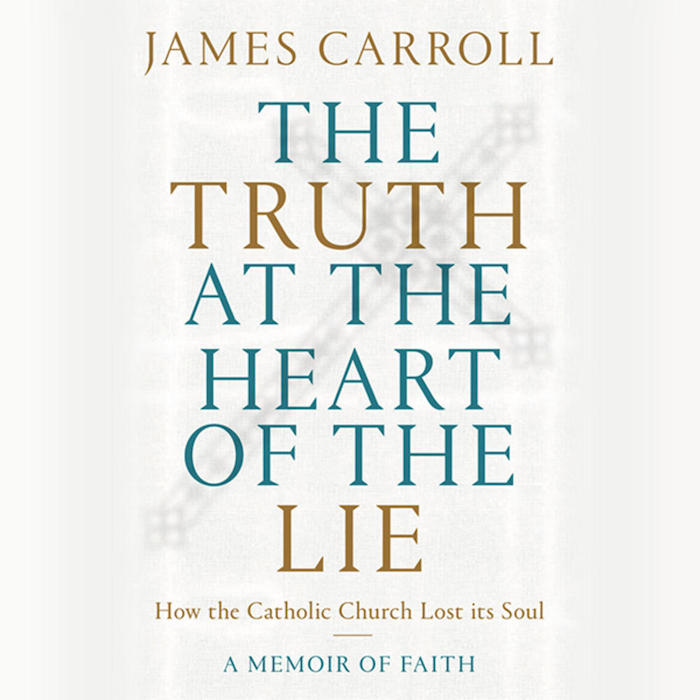
Sitting on billions, Catholic dioceses amassed taxpayer aid
By REESE DUNKLIN and MICHAEL REZENDES
When the coronavirus forced churches to close their doors and give up Sunday collections, the Roman Catholic Diocese of Charlotte turned to the federal government’s signature small business relief program for more than $8 million.
The diocese’s headquarters, churches and schools landed the help even though they had roughly $100 million of their own cash and short-term investments available last spring, financial records show. When the cash catastrophe church leaders feared didn’t materialize, those assets topped $110 million by the summer.
“I am gratified to report the overall good financial health of the diocese despite the many difficulties presented by the Covid-19 pandemic,” Bishop Peter Jugis wrote in the diocese’s audited financial report released last fall.
As the pandemic began to unfold, scores of Catholic dioceses across the U.S. received aid through the Paycheck Protection Program while sitting on well over $10 billion in cash, short-term investments or other available funds, an Associated Press investigation has found. And despite the broad economic downturn, these assets have grown in many dioceses.
Yet even with that financial safety net, the 112 dioceses that shared their financial statements, along with the churches and schools they oversee, collected at least $1.5 billion in taxpayer-backed aid. A majority of these dioceses reported enough money on hand to cover at least six months of operating expenses, even without any new income.
The financial resources of several dioceses rivaled or exceeded those available to publicly traded companies like Shake Shack and Ruth’s Chris Steak House, whose early participation in the program triggered outrage. Federal officials responded by emphasizing the money was intended for those who lacked the cushion that cash and other liquidity provide. Many corporations returned the funds.
Overall, the nation’s nearly 200 dioceses, where bishops and cardinals govern, and other Catholic institutions received at least $3 billion. That makes the Roman Catholic Church perhaps the biggest beneficiary of the paycheck program, according to AP’s analysis of data the U.S. Small Business Administration released following a public-records lawsuit by news organizations. The agency for months had shared only partial information, making a more precise analysis impossible.
Already one of the largest federal aid efforts ever, the SBA reopened the Paycheck Protection Program last month with a new infusion of nearly $300 billion. In making the announcement, the agency’s administrator at the time, Jovita Carranza, hailed the program for serving “as an economic lifeline to millions of small businesses.”
Church officials have said their employees were as worthy of help as workers at Main Street businesses, and that without it they would have had to slash jobs and curtail their charitable mission as demand for food pantries and social services spiked. They point out the program’s rules didn’t require them to exhaust their stores of cash and other funds before applying.
But new financial statements several dozen dioceses have posted for 2020 show that their available resources remained robust or improved during the pandemic’s hard, early months. The pattern held whether a diocese was big or small, urban or rural, East or West, North or South.
In Kentucky, funds available to the Archdiocese of Louisville, its parishes and other organizations grew from at least $153 million to $157 million during the fiscal year that ended in June, AP found. Those same offices and organizations received at least $17 million in paycheck money. “The Archdiocese’s operations have not been significantly impacted by the Covid-19 outbreak,” according to its financial statement.
In Illinois, the Archdiocese of Chicago had more than $1 billion in cash and investments in its headquarters and cemetery division as of May, while the faithful continued to donate “more than expected,” according to a review by the independent ratings agency Moody’s Investors Service. Chicago’s parishes, schools and ministries accumulated at least $77 million in paycheck protection funds.
Up the interstate from Charlotte in North Carolina, the Raleigh Diocese collected at least $11 million in aid. Yet during the fiscal year that ended in June, overall offerings were down just 5% and the assets available to the diocese, its parishes and schools increased by about $21 million to more than $170 million, AP found. In another measure of fiscal health, the diocese didn’t make an emergency draw on its $10 million line of credit.
Catholic leaders in dioceses including Charlotte, Chicago, Louisville and Raleigh said their parishes and schools, like many other businesses and nonprofits, suffered financially when they closed to slow the spread of the deadly coronavirus.
Some dioceses reported that their hardest-hit churches saw income drop by 40% or more before donations began to rebound months later, and schools took hits when fundraisers were canceled and families had trouble paying tuition. As revenues fell, dioceses said, wage cuts and a few dozen layoffs were necessary in some offices.
Catholic researchers at Georgetown University who surveyed the nation’s bishops last summer found such measures weren’t frequent. In comparison, a survey by the investment bank Goldman Sachs found 42% of small business owners had cut staff or salaries, and that 33% had spent their personal savings to stay open.
Church leaders have questioned why AP focused on their faith following a story last July, when New York Cardinal Timothy Dolan wrote that reporters “invented a story when none existed and sought to bash the Church.”
By using a special exemption that the church lobbied to include in the paycheck program, Catholic entities amassed at least $3 billion — roughly the same as the combined total of recipients from the other faiths that rounded out the top five, AP found. Baptist, Lutheran, Methodist and Jewish faith-based recipients also totaled at least $3 billion. Catholics account for about a fifth of the U.S. religious population while members of Protestant and Jewish denominations are nearly half, according to the Pew Research Center.
Catholic institutions also received many times more than other major nonprofits with charitable missions and national reach, such as the United Way, Goodwill Industries and Boys & Girls Clubs of America. Overall, Catholic recipients got roughly twice as much as 40 of the largest, most well-known charities in America combined, AP found.
The complete picture is certainly even more lopsided. So many Catholic entities received help that reporters could not identify them all, even after spending hundreds of hours hand-checking tens of thousands of records in federal data.
The Vatican referred questions about the paycheck program to the United States Conference of Catholic Bishops, which said it does not speak on behalf of dioceses.
Presented with AP’s findings, bishops conference spokeswoman Chieko Noguchi responded with a broad statement that the Paycheck Protection Program was “designed to protect the jobs of Americans from all walks of life, regardless of whether they work for for-profit or nonprofit employers, faith-based or secular.”
INTERNAL SKEPTICISM
The AP’s assessment of church finances is among the most comprehensive to date. It draws largely from audited financial statements posted online by the central offices of 112 of the country’s nearly 200 dioceses.
The church isn’t required to share its financials. As a result, the analysis doesn’t include cash, short-term assets and lines of credit held by some of the largest dioceses, including those serving New York City and other major metropolitan areas.
The analysis focused on available assets because federal officials cited those metrics when clarifying eligibility for the paycheck program. Therefore, the $10 billion AP identified doesn’t count important financial pillars of the U.S. church. Among those are its thousands of real estate properties and most of the funds that parishes and schools hold. Also excluded is the money — estimated at $9.5 billion in a 2019 study by the Delaware-based wealth management firm Wilmington Trust — held by charitable foundations created to help dioceses oversee donations.
In addition, dioceses can rely on a well-funded support system that includes help from wealthier dioceses, the bishops conference and other Catholic organizations. Canon law, the legal code the Vatican uses to govern the global church, notes that richer dioceses may assist poorer ones, and the AP found instances where they did.
In their financial statements, the 112 dioceses acknowledged having at least $4.5 billion in liquid or otherwise available assets. To reach its $10 billion total, AP also included funding that dioceses had opted to designate for special projects instead of general expenses; excess cash that parishes and their affiliates deposit with their diocese’s savings and loan; and lines of credit dioceses typically have with outside banks.
Some church officials said AP was misreading their financial books and therefore overstating available assets. They insisted that money their bishop or his advisers had set aside for special projects couldn’t be repurposed during an emergency, although financial statements posted by multiple dioceses stated the opposite.
For its analysis, AP consulted experts in church finance and church law. One was the Rev. James Connell, an accountant for 15 years before joining the priesthood and becoming an administrator in the Milwaukee Archdiocese. Connell, also a canon lawyer who is now retired from his position with the archdiocese, said AP’s findings convinced him that Catholic entities did not need government aid — especially when thousands of small businesses were permanently closing.
“Was it want or need?” Connell asked. “Need must be present, not simply the want. Justice and love of neighbor must include the common good.”
Connell was not alone among the faithful concerned by the church’s pursuit of taxpayer money. Parishioners in several cities have questioned church leaders who received government money for Catholic schools they then closed.
Elsewhere, a pastor in a Western state told AP that he refused to apply even after diocesan officials repeatedly pressed him. He spoke on condition of anonymity because of his diocese’s policy against talking to reporters and concerns about possible retaliation.
The pastor had been saving, much like leaders of other parishes. When the pandemic hit, he used that money, trimmed expenses and told his diocese’s central finance office that he had no plans to seek the aid. Administrators followed up several times, the pastor said, with one high-ranking official questioning why he was “leaving free money on the table.”
The pastor said he felt a “sound moral conviction” that the money was meant more for shops and restaurants that, without it, might close forever.
As the weeks passed last spring, the pastor said his church managed just fine. Parishioners were so happy with new online Masses and his other outreach initiatives, he said, they boosted their contributions beyond 2019 levels.
“We didn’t need it,” the pastor said, “and intentionally wanted to leave the money for those small business owners who did.”
WEATHERING A DOWNTURN
Months after the pandemic first walloped the economy, the 112 dioceses that release financial statements began sharing updates. Among the 47 dioceses that have thus far, the pandemic’s impact was far from crippling.
The 47 dioceses that have posted financials for the fiscal year that ended in June had a median 6% increase in the amount of cash, short-term investments and other funds that they and their affiliates could use for unanticipated or general expenses, AP found. In all, 38 dioceses grew those resources, while nine reported declines.
Finances in Raleigh and 10 other dioceses that took government assistance were stable enough that they did not have to dip into millions they had available through outside lines of credit.
“This crisis has tested us,” Russell Elmayan, Raleigh’s chief financial officer, told the diocese’s magazine website in July, “but we are hopeful that the business acumen of our staff and lay counselors, together with the strategic financial reserves built over time, will help our parishes and schools continue to weather this unprecedented event.” Raleigh officials did not answer direct questions from AP.
The 47 dioceses acknowledged a smaller amount of readily available assets than AP counted, though by their own accounting that grew as well.
The improving financial outlook is due primarily to parishioners who found ways to continue donating and U.S. stock markets that were rebounding to new highs. But when the markets were first plunging, officials in several dioceses said, they had to stretch available assets because few experts were forecasting a rapid recovery.
In Louisville, Charlotte and other dioceses, church leaders said they offered loans or grants to needy parishes and schools, or offset the monthly charges they assess their parishes. In Raleigh, for example, the headquarters used $3 million it had set aside for liability insurance and also tapped its internal deposit and loan fund.
Church officials added that the pandemic’s full toll will probably be seen in a year or two, because some key sources of revenue are calculated based on income that parishes and schools generate.
“We believe that we will not know all of the long-term negative impacts on parish, school and archdiocesan finances for some time,” Louisville Archdiocese spokeswoman Cecelia Price wrote in response to questions.
At the nine dioceses that recorded declines in liquid or other short-term assets, the drops typically were less than 10%, and not always clearly tied to the pandemic.
The financial wherewithal of some larger dioceses is underscored by the fact that, like publicly traded companies, they can raise capital by selling bonds to investors.
One was Chicago, where analysts with the Moody’s ratings agency calculated that the $1 billion in cash and investments held by the archdiocese headquarters and cemeteries division could cover about 631 days of operating expenses.
Church officials in Chicago asserted that those dollars were needed to cover substantial expenses while parishioner donations slumped. Without paycheck support, “parishes and schools would have been forced to cut many jobs, as the archdiocese, given its liabilities, could not have closed such a funding gap,” spokeswoman Paula Waters wrote.
Moody’s noted in its May report that while giving was down, federal aid had compensated for that and helped leave the archdiocese “well positioned to weather this revenue loss over the next several months.” Among the reasons for the optimism: “a unique credit strength” that under church law allows the archbishop to tax parish revenue virtually at will.
In a separate Moody’s report on New Orleans, which filed for bankruptcy in May while facing multiple clergy abuse lawsuits, the ratings agency wrote in July that the archdiocese did so while having “significant financial reserves, with spendable cash and investments of over $160 million.”
Moody’s said the archdiocese’s “very good” liquid assets would let it operate 336 days without additional income. Those assets prompted clergy abuse victims to ask a federal judge to dismiss the bankruptcy filing, arguing the archdiocese’s primary reason for seeking the legal protection was to minimize payouts to them.
The archdiocese, along with its parishes and schools, collected more than $26 million in paycheck money. New Orleans Archdiocesan officials didn’t respond to written questions.
PURSUING AID
Without special treatment, the Catholic Church would not have received nearly so much under the Paycheck Protection Program.
After Congress let nonprofits and religious organizations participate in the first place, Catholic officials lobbied the Trump Administration for a second break. Religious organizations were freed from the so-called affiliation rule that typically disqualifies applicants with more than 500 workers.
Without that break, many dioceses would have missed out because — between their head offices, parishes, schools and other affiliates — their employee count would exceed the limit.
Among those lobbying, federal records show, was the Los Angeles Archdiocese. Parishes, schools and ministries there collected at least $80 million in paycheck aid, at a time when the headquarters reported $658 million in available funds heading into the fiscal year when the coronavirus arrived.
Catholic officials in the U.S. needed the special exception for at least two reasons.
Church law says dioceses, parishes and schools are affiliated, something the Los Angeles Archdiocese acknowledged “proved to be an obstacle” to receiving funds because its parishes operate “under the authority of the diocesan bishop.” Dioceses, parishes, schools and other Catholic entities also routinely assert to the Internal Revenue Service that they are affiliated so they can maintain their federal income tax exemption.
While some Catholic officials insisted their affiliates are separate and financially independent, AP found many instances of borrowing and spending among them when dioceses were faced with prior cash crunches. In Philadelphia, for example, the archdiocese received at least $18 million from three affiliates, including a seminary, to fund a compensation program for clergy sex abuse survivors, according to 2019 financial statements.
Cardinals and bishops have broad authority over parishes and the pastors who run them. Church law requires parishes to submit annual financial reports and bishops may require parishes to deposit surplus money with internal banks administered by the diocese.
“The parishioners cannot hire or fire the pastor; that is for the bishop to do,” said Connell, the priest, former accountant and canon lawyer. “Each parish functions as a wholly owned subsidiary or division of a larger corporation, the diocese.”
Bishops acknowledged a concerted effort to tap paycheck funds in a survey by Catholic researchers at Georgetown University. When asked what they had done to address the pandemic’s financial fallout, 95% said their central offices helped parishes apply for paycheck and other aid — the leading response. That topped encouraging parishioners to donate electronically.
After Congress approved the paycheck program, three high-ranking officials in New Hampshire’s Manchester Diocese sent an urgent memo to parishes, schools and affiliated organizations urging them to refrain from layoffs or furloughs until completing their applications. “We are all in this together,” the memo read, adding that diocesan officials were working expeditiously to provide “step by step instructions.”
Paycheck Protection Program funds came through low-interest bank loans, worth up to $10 million each, that the federal government would forgive so long as recipients used the money to cover about two months of wages and operating expenses.
After an initial $659 billion last spring, Congress added another $284 billion in December. With the renewal came new requirements intended to ensure that funds go to businesses that lost money due to the pandemic. Lawmakers also downsized the headcount for applicants to 300 or fewer employees.
A QUESTION OF NEED
In other federal small business loan programs, government help is treated as a last resort.
Applicants must show they couldn’t get credit elsewhere. And those with enough available funds must pay more of their own way to reduce taxpayer subsidies.
Congress didn’t include these tests in the Paycheck Protection Program. To speed approvals, lenders weren’t required to do their usual screening and instead relied on applicants’ self-certifications of need.
The looser standards helped create a run on the first $349 billion in paycheck funding. Small business owners complained that they were shut out, yet dozens of companies healthy enough to be traded on stock exchanges scored quick approval.
As blowback built in April, Treasury Secretary Steven Mnuchin warned at a news briefing that there would be “severe consequences” for applicants who improperly tapped the program.
“We want to make sure this money is available to small businesses that need it, people who have invested their entire life savings,” Mnuchin said. Program guidelines evolved to stress that participants with access to significant cash probably could not get the assistance “in good faith.”
Mnuchin’s Treasury Department said it would audit loans exceeding $2 million, although federal officials have not said whether they would hold religious organizations and other nonprofits to the same standard of need as businesses.
The headquarters and major departments for more than 40 dioceses received more than $2 million. Every diocese that responded to questions said it would seek to have the government cover the loans, rather than repay the funds.
One diocese receiving a loan over $2 million was Boston. According to the archdiocese’s website, its central ministries office received about $3 million, while its parishes and schools collected about $32 million more.
The archdiocese — along with its parishes, schools and cemeteries — had roughly $200 million in available funds in June 2019, according to its audited financial report. When that fiscal year ended several months into the pandemic, available funds had increased to roughly $233 million.
Nevertheless, spokesman Terrence Donilon cited “ongoing economic pressure” in saying the archdiocese will seek forgiveness for last year’s loans and will apply for additional, new funds during the current round.
Beyond its growing available funds, the archdiocese and its affiliates benefit from other sources of funding. The archdiocese’s “Inspiring Hope” campaign, announced in January, has raised at least $150 million.
And one of its supporting charities — the Catholic Schools Foundation, where Cardinal Sean O’Malley is board chairman — counted more than $33 million in cash and other funds that could be “used for general operations” as of the beginning of the 2020 fiscal year, according to its financial statement.
Despite these resources, the archdiocese closed a half-dozen schools in May and June, often citing revenue losses due to the pandemic. Paycheck protection data show four of those schools collectively were approved for more than $700,000.
The shuttered schools included St. Francis of Assisi in Braintree, a middle-class enclave 10 miles south of Boston, which received $210,000. Parents said they felt blindsided by the closure, announced in June as classes ended.
“It’s like a punch to the gut because that was such a home for so many people for so long,” said Kate Nedelman Herbst, the mother of two children who attended the elementary school.
Along with more than 2,000 other school supporters, Herbst signed a written protest to O’Malley that noted the archdiocese’s robust finances. After O’Malley didn’t reply, parents appealed to the Vatican, this time underscoring the collection of Paycheck Protection Program money.
“It is very hard to reconcile the large sums of money raised by the archdiocese in recent years with this wholesale destruction of the church’s educational infrastructure,” parents wrote.
In December, the Vatican turned down their request to overrule O’Malley. Spokesman Donilon said the decision to close the school “is not being reconsidered.”
Today, the three children of Michael Waterman and his wife, Jeanine, are learning at home. And they still can’t understand why the archdiocese didn’t shift money to help save a school beloved by the faithful.
“What angers us,” Michael Waterman said, “is that we feel like, given the amount of money that the Catholic Church has, they absolutely could have remained open.”
Complete Article ↪HERE↩!
Social Distancing
Now look what you’ve gone and done, Francis!
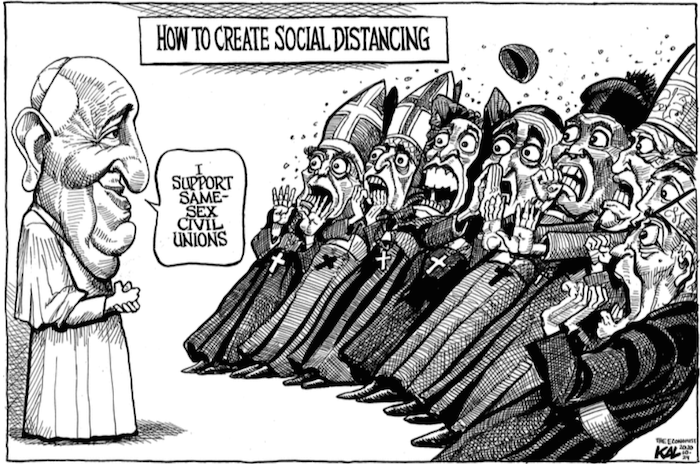
The Catholic Church Is Breaking People’s Hearts
It fires gay workers, vilifies gay priests and alienates parishioners who can’t make any sense of this.
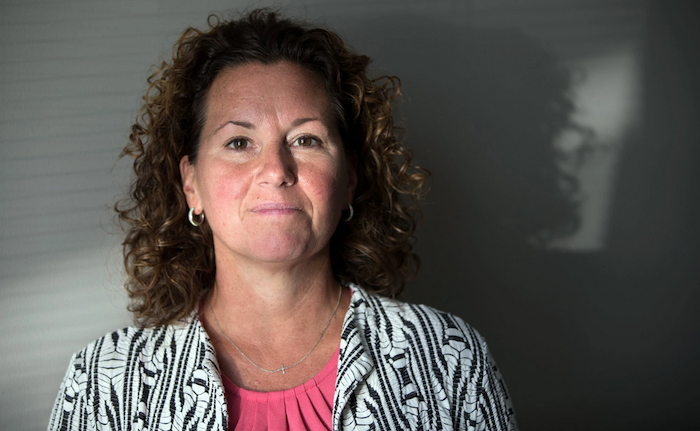
By Frank Bruni
Pat Fitzgerald, 67, has long loved being a Catholic, and the part he loved maybe most of all, for the past quarter-century, was his role as a spiritual mentor at retreats for students at a church-affiliated high school in Indianapolis, where he lives.
But he has been told that he’s not wanted anymore. His crime? He publicly supported his daughter, a guidance counselor at the school, after its administrators moved to get rid of her because she’s married to a woman.
The school’s treatment of Shelly Fitzgerald, 45, was a big local story last summer that went national; she ended up on “The Ellen DeGeneres Show” in September. It was one of many examples of Catholic institutions deciding almost whimsically to exile longtime employees — not priests or nuns but coaches, teachers, counselors — who had long been known to be gay but were suddenly regarded as liabilities.
Maybe they had quietly married their partners, formalizing those relationships and inadvertently drawing attention to themselves. Maybe some homophobic parent or congregant had belatedly learned about them and lodged a complaint. That’s what happened to Shelly Fitzgerald, and her 14 years of fine work at Roncalli High School no longer mattered. Only her 2015 marriage to her longtime partner did. She was told that she could stay on if she dissolved the union. She said no thanks and was kicked off school grounds in August.
The aftershocks still complicate the lives — and faith — of people around her: her students, their parents, her dad. On Facebook last month she posted a letter from him to the Roncalli community in which he explained that he’d just been disinvited from future retreats but thanked everyone for being such supportive friends over the years.
“Today my heart is broken,” he wrote, adding that the retreats he’d participated in — more than 40 in all — were “the most beautiful and holy settings I have ever witnessed.” He alluded only vaguely to his daughter’s case. “To people on both sides of this ongoing issue,” he wrote, “I hope you can find peace.”
But there’s no peace for the Catholic Church here. It’s too mired in its own hypocrisy. The tension between its official teaching and unofficial practice — between the ignorance of the past and the illumination of the present — grows tauter all the time.
Most Catholics support same-sex marriage, in defiance of the church’s formal position, and many parishes fully welcome L.G.B.T. people. Yet there are places, and times, when the hammer comes down.
Church leaders know full well that the priesthood would be decimated if closeted gay men were exposed and expelled. Yet the church as a matter of policy bars men with “deep-seated homosexual tendencies” and considers gay people “objectively disordered.”
Catholics are supposed to show compassion. Yet Shelly and her dad were shown anything but.
She has been on administrative leave since August, and last month her lawyer, David Page, filed a charge of discrimination against the school and the Archdiocese of Indianapolis with the federal Equal Employment Opportunity Commission. It has up to 180 days to respond.
On Tuesday morning he showed me paperwork for a second charge of discrimination that he said he would be filing imminently; it cites what happened to her father as an unlawful act of retaliation meant to dissuade Shelly from pressing her case.
Pat Fitzgerald, uncomfortable with media attention, declined to speak with me, preferring to let his daughter do the talking. “His struggle comes from caring about Roncalli and being in conflict with what they’ve done to me,” Shelly told me. In October he attended a protest against the church’s treatment of L.G.B.T. people. His sign said, “Please treat my daughter Shelly kindly.”
There is, by many accounts, profound anger and hurt at Roncalli. As it happens, Shelly was one of two directors of counseling there; the other, Lynn Starkey, 62, is in a same-sex civil union and in November filed her own charge of discrimination with the E.E.O.C., claiming a “hostile work environment” in the aftermath of Shelly’s departure. For now she remains on the job.
Many students started an L.G.B.T. advocacy group, Shelly’s Voice, that also attracted parents and other adults in the community. A related Facebook page, Time to Be a Rebel, has more than 4,500 members.
But one parent told me that students who question Shelly’s dismissal fear repercussions. “Seniors are being told that if they speak out, they take the chance of not being able to graduate,” the parent, who spoke with me on condition of anonymity, said.
Sign up for Frank Bruni’s newsletter
Get a more personal, less conventional take on political developments, newsmakers, cultural milestones and more with Frank Bruni’s exclusive commentary every week.
According to posts on the Facebook page, a small cluster of Roncalli students were invited last month to a lunch with Archbishop Charles C. Thompson of Indianapolis, only to have him stress that homosexuality is a disorder and its expression sinful. One student called it an ambush.
For comment on all of this, I contacted the Roncalli principal, who referred me to a spokesman for the archdiocese. The spokesman sent me a statement that said that Pat Fitzgerald’s exclusion from student retreats reflected the “continuing attention surrounding his daughter’s suspension” and “his own participation in public protests over Catholic Church teaching.” He was still welcome at Masses, the statement said.
In regard to Shelly’s suspension, a past statement from the archdiocese reiterated what the Catholic Church has said in similar cases: Employees of Catholic schools are expected to live in compliance with church teaching. But is that legally enforceable?
Shelly’s E.E.O.C. complaint tests where federal civil rights law covers sexual orientation, a matter on which courts in different areas of the country have disagreed. Also, the Catholic Church has attempted to claim a “ministerial exception” from nondiscrimination laws that conflict with religious tenets, but there’s continued dispute about whether this applies to workers, like Shelly, who aren’t in the clergy.
Shelly pointed out that the Catholic Church isn’t generally going after teachers who flout its rules by using birth control or divorcing or having sexual relations outside marriage. “They’re going after L.G.B.T. people,” she said. “They’re going to die on this hill.”
And they’re going to hurt people — like Shawn Aldrich, who attended Roncalli, just as his parents and his wife and her parents did. He has two children there now. What has happened to Shelly astounds him.
“She was phenomenal at her job,” Aldrich told me. “So why are we dismissing her?” He knows what church leaders say about homosexuality but noted, “It’s our church, too.” Besides, he said, “All of us are made in God’s image.”
He and his wife plan to end their family tradition. They won’t send their third child, now in seventh grade, to Roncalli. “And that breaks our hearts,” he said. “That absolutely breaks our hearts.”
Complete Article ↪HERE↩!
‘It Is Not a Closet. It Is a Cage.’
Gay Catholic Priests Speak Out

The crisis over sexuality in the Catholic Church goes beyond abuse. It goes to the heart of the priesthood, into a closet that is trapping thousands of men.
Gregory Greiten was 17 years old when the priests organized the game. It was 1982 and he was on a retreat with his classmates from St. Lawrence, a Roman Catholic seminary for teenage boys training to become priests. Leaders asked each boy to rank which he would rather be: burned over 90 percent of his body, paraplegic, or gay.
Each chose to be scorched or paralyzed. Not one uttered the word “gay.” They called the game the Game of Life.
The lesson stuck. Seven years later, he climbed up into his seminary dorm window and dangled one leg over the edge. “I really am gay,” Father Greiten, now a priest near Milwaukee, remembered telling himself for the first time. “It was like a death sentence.”
The closet of the Roman Catholic Church hinges on an impossible contradiction. For years, church leaders have driven gay congregants away in shame and insisted that “homosexual tendencies” are “disordered.” And yet, thousands of the church’s priests are gay.
The stories of gay priests are unspoken, veiled from the outside world, known only to one another, if they are known at all.
Fewer than about 10 priests in the United States have dared to come out publicly. But gay men likely make up at least 30 to 40 percent of the American Catholic clergy, according to dozens of estimates from gay priests themselves and researchers. Some priests say the number is closer to 75 percent. One priest in Wisconsin said he assumed every priest is gay unless he knows for a fact he is not. A priest in Florida put it this way: “A third are gay, a third are straight, and a third don’t know what the hell they are.”
Two dozen gay priests and seminarians from 13 states shared intimate details of their lives in the Catholic closet with The New York Times over the past two months. They were interviewed in their churches before Mass, from art museums on the weekend, in their apartments decorated with rainbow neon lights, and between classes at seminary. Some agreed to be photographed if their identities were concealed.
Almost all of them required strict confidentiality to speak without fear of retribution from their bishops or superiors. A few had been expressly forbidden to come out or even to speak about homosexuality. Most are in active ministry, and could lose more than their jobs if they are outed. The church almost always controls a priest’s housing, health insurance and retirement pension. He could lose all three if his bishop finds his sexuality disqualifying, even if he is faithful to his vows of celibacy.
The environment for gay priests has grown only more dangerous. The fall of Theodore McCarrick, the once-powerful cardinal who was defrocked last week for sexual abuse of boys and young men, has inflamed accusations that homosexuality is to blame for the church’s resurgent abuse crisis.
Studies repeatedly find there to be no connection between being gay and abusing children. And yet prominent bishops have singled out gay priests as the root of the problem, and right-wing media organizations attack what they have called the church’s “homosexual subculture,” “lavender mafia,” or “gay cabal.”
Even Pope Francis has grown more critical in recent months. He has called homosexuality “fashionable,” recommended that men with “this deep-seated tendency” not be accepted for ministry, and admonished gay priests to be “perfectly responsible, trying to never create scandal.”
This week, Pope Francis will host a much-anticipated summit on sex abuse with bishops from around the world. The debate promises to be not only about holding bishops accountable but also about homosexuality itself.
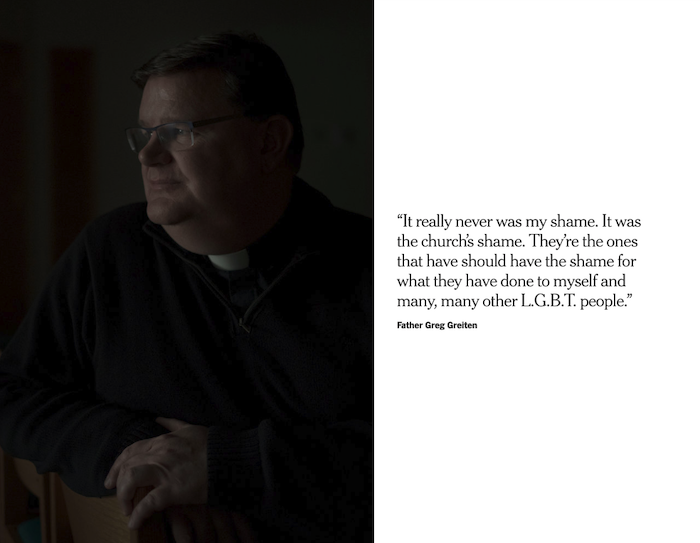
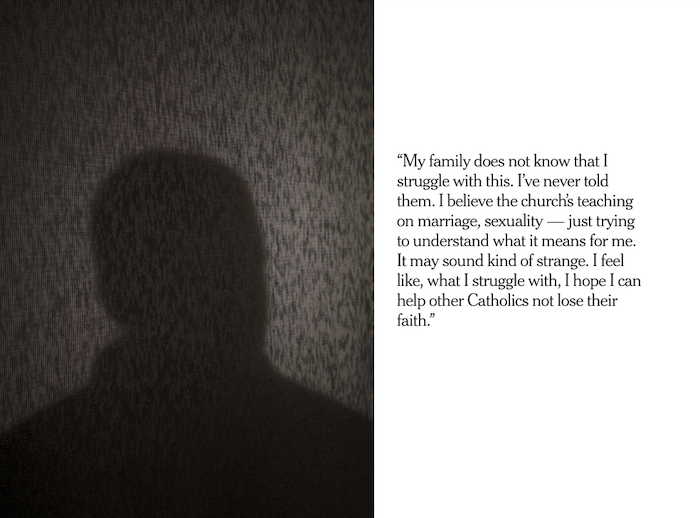
“This is my life,” a parish priest in the Northeast said. “You feel like everyone is on a witch hunt now for things you have never done.”
Just a few years ago, this shift was almost unimaginable. When Pope Francis uttered his revolutionary question, “Who am I to judge?” in 2013, he tempted the closet door to swing open. A cautious few priests stepped through.
But if the closet door cracked, the sex abuse crisis now threatens to slam it shut. Widespread scapegoating has driven many priests deeper into the closet.
“The vast majority of gay priests are not safe,” said Father Bob Bussen, a priest in Park City, Utah, who was outed about 12 years ago after he held mass for the L.G.B.T.Q. community.
“Life in the closet is worse than scapegoating,” he said. “It is not a closet. It is a cage.”
“You can be taught to act straight in order to survive.”
Even before a priest may know he is gay, he knows the closet. The code is taught early, often in seminary. Numquam duo, semper tres, the warning goes. Never two, always three. Move in trios, never as a couple. No going on walks alone together alone, no going to the movies in a pair. The higher-ups warned for years: Any male friendship is too dangerous, could slide into something sexual, and turn into what they called a “particular friendship.”
“You couldn’t have a particular friendship with a man, because you might end up being homosexual,” explained a priest, who once nicknamed his friends “the P.F.s.” “And you couldn’t have a friendship with a woman, because you might end up falling in love, and they were both against celibacy. With whom do you have a relationship that would be a healthy human relationship?”
Today, training for the priesthood in the United States usually starts in or after college. But until about 1980, the church often recruited boys to start in ninth grade — teenagers still in the throes of puberty. For many of today’s priests and bishops over 50, this environment limited healthy sexual development. Priests cannot marry, so sexuality from the start was about abstinence, and obedience.


The sexual revolution happening outside seminary walls might as well have happened on the moon, and national milestones in the fight for gay rights like the Stonewall riots, on Mars.
One priest in a rural diocese said the rules reminded him of how his elementary school forced left-handed students to write with their right hand. “You can be taught to act straight in order to survive,” he said.
“I can still remember seeing a seminarian come out of another’s room at 5 a.m. and thinking, isn’t it nice, they talked all night,” the same priest said. “I was so naïve.”
Priests in America tend to come out to themselves at a much later age than the national average for gay men, 15. Many gay priests spoke of being pulled between denial and confusion, finally coming out to themselves in their 30s or 40s.
Father Greiten was 24 when he realized he was gay and considered jumping from his dorm window. He did not jump, but confided his despair in a classmate. His friend came out himself. It was a revelation: There were other people studying to be priests who were gay. It was just that no one talked about it.
He reached out to a former seminary professor who he thought might also be a gay man.
“There will be a time in your life when you will look back on this and you’re going to just love yourself for being gay,” Father Greiten remembered this man telling him. “I thought, ‘This man must be totally insane.’”
But he had discovered the strange irony of the Catholic closet — it isn’t secret at all.
“It’s kind of like an open closet,” Father Greiten said. “It’s the making of it public, and speaking about it, where it becomes an issue.”
One priest, whose parish has no idea he is gay, remembered a backyard cocktail party a few years ago where fellow priests were saying “vile” things about a gay bishop. He intervened, and came out to them. He lost three friends that night. “I broke the code by announcing to them that I was gay,” he said. “It was a conspiracy of silence.”
That is a reason many of the men are out to only a few close friends. The grapevine has taught them which priests in their diocese are gay, whom to trust, and whom to fear.
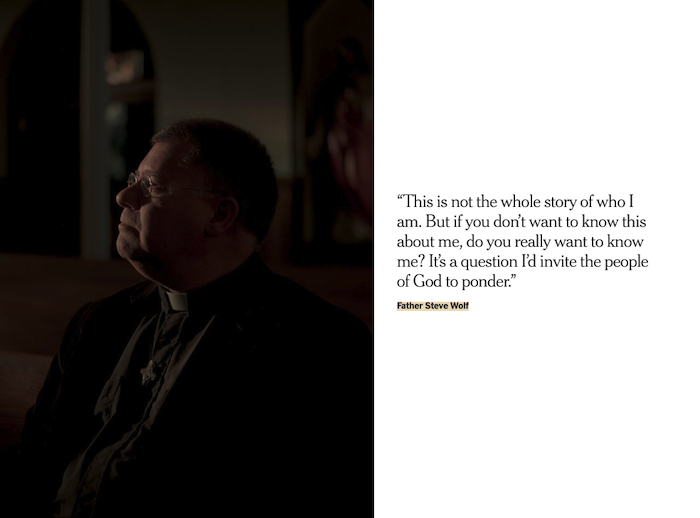
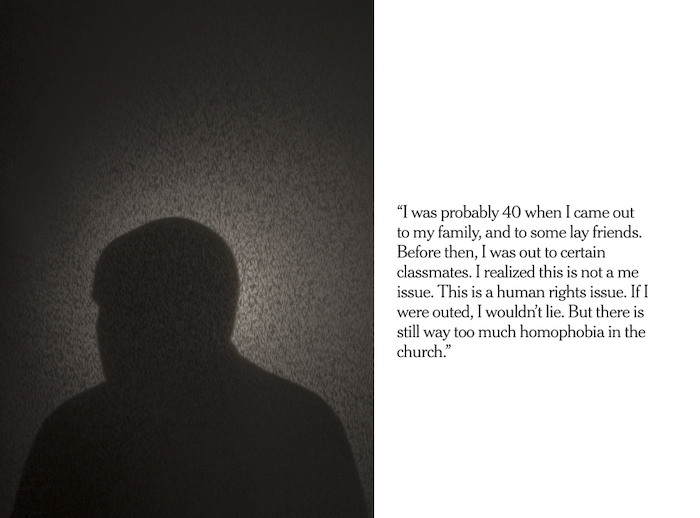
All priests must wrestle with their vows of celibacy, and the few priests who are publicly out make clear they are chaste.
Still, many priests said they have had sex with other men to explore their sexual identity. Some have watched pornography to see what it was like for two men to have sex. They ultimately found more anguish than pleasure.
One priest had sex for the first time at 62, no strings attached, with a man he met online. The relationship was discovered and reported to his bishop, and he has not had sex since. Another priest, when asked if he had ever considered himself as having a partner, wondered what that even meant. He paused, before mentioning one very special friend. “I fell in love several times with men,” he said. “I knew from the beginning it wasn’t going to last.”
Though open, the closet means that many priests have held the most painful stories among themselves for decades: The seminarian who died by suicide, and the matches from a gay bar found afterward in his room. The priest friends who died of AIDS. The feeling of coming home to an empty rectory every night.
So they find ways to encourage one other. They share books like Father James Martin’s groundbreaking “Building a Bridge,” on the relationship between the Catholic and L.G.B.T. communities. Some have signed petitions against church-sponsored conversion therapy programs, or have met on private retreats, after figuring out how to conceal them on their church calendars. Occasionally, a priest may even take off his collar and offer to unofficially bless a gay couple’s marriage.
Some may call this rebellion. But “it is not a cabal,” one priest said. “It is a support group.”
Just over a year ago, after meeting with a group of gay priests, Father Greiten decided it was time to end his silence. At Sunday Mass, during Advent, he told his suburban parish he was gay, and celibate. They leapt to their feet in applause.
His story went viral. A 90-year-old priest called him to say he had lived his entire life in the closet and longed for the future to be different. A woman wrote from Mississippi, asking him to move south to be her priest.
To some church leaders, that outpouring of support may have been even more threatening than his sexuality. Father Greiten had committed the cardinal sin: He opened the door to debate. His archbishop, Jerome E. Listecki of Milwaukee, issued a statement saying that he wished Father Greiten had not gone public. Letters poured in calling him “satanic,” “gay filth,” and a “monster” who sodomized children.
“We have to get it right when it comes to sexuality.”
The idea that gay priests are responsible for child sexual abuse remains a persistent belief, especially in many conservative Catholic circles. For years, church leaders have been deeply confused about the relationship between gay men and sexual abuse. With every new abuse revelation, the tangled threads of the church’s sexual culture become even more impossible to sort out.
Study after study shows that homosexuality is not a predictor of child molestation. This is also true for priests, according to a famous studyby John Jay College of Criminal Justice in the wake of revelations in 2002 about child sex abuse in the church. The John Jay research, which church leaders commissioned, found that same-sex experience did not make priests more likely to abuse minors, and that four out of five people who said they were victims were male. Researchers found no single cause for this abuse, but identified that abusive priests’ extensive access to boys had been critical to their choice of victims.
The notion that a certain sexual identity leads to abusive behavior has demoralized gay priests for decades. Days after one man retired, he still could not shake what his archbishop in the 1970s told all the new priests headed to their first parish assignments. “He said, ‘I don’t ever want you to call me to report about your pastor, unless he is a homo or an alchie,’” he said, referring to an alcoholic. “He didn’t even know what he meant when he said homo, because we were all homos. He meant a predator, like serial predator.”
This perception persists today at prominent Catholic seminaries. At the largest in the United States, Mundelein Seminary in Illinois, few ever talk about sexual identity, said one gay student, who is afraid to ever come out. Since last summer, when Mr. McCarrick was exposed for abusing young men, students have been drilled in rules about celibacy and the evils of masturbation and pornography.
“Classmates will say, ‘Don’t admit gays,’” said the student. “Their attitude is that it is gay priests who inflict abuse on younger guys.”
Priests across the country are wondering if their sacrifice is worth the personal cost. “Am I going to leave the priesthood because I’m sick of that accusation?” asked Father Michael Shanahan, a Chicago priest who came out publicly three years ago. “Become more distant from parishioners? Am I going to hide? Become hardened, and old?”
Blaming sexual abuse on gay men is almost sure to be a major topic this week at the Vatican, at a much-anticipated four-day summit on sexual abuse. Pope Francis has called the world’s most powerful bishops to Rome to educate them on the problems of abuse, after high-profile abuses cases in the United States, Australia, Chile and elsewhere.
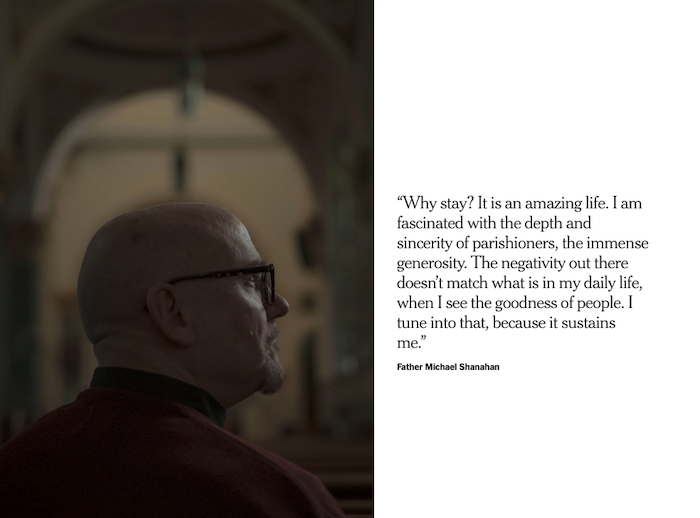
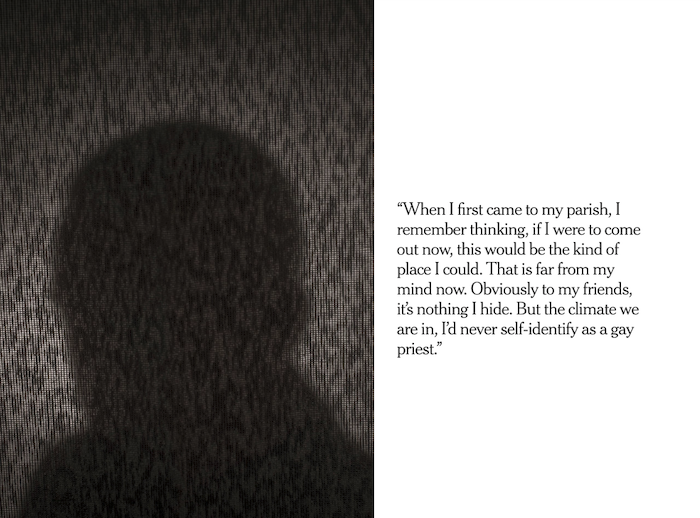
The event has worried gay priests. A few years after the 2002 scandal, the Vatican banned gay men from seminaries and ordination. When the abuse crisis broke out again last summer, the former Vatican ambassador to the United States, Archbishop Carlo Maria Viganò, accused “homosexual networks” of American cardinals of secretly working to protect abusers. And this week, a sensational book titled “Sodoma” in Europe (“In the Closet of the Vatican” in the United States) is being released that claims to expose a vast gay subculture at the Vatican.
A group of gay priests in the Netherlands recently took the unusually bold step of writing to Pope Francis, urging him to allow gay, celibate men to be ordained.
“Instead of seeing increased accountability on the parts of the bishops, it could become once again a condemnation of lesbian, gay, transsexual people within the church,” said John Coe, 63, a permanent deacon in Kentucky, who came out last year.
Sitting in his parish’s small counseling room, Father Greiten reflected on it all. He wished he could talk to Pope Francis himself. “Listen to my story of how the church traumatized me for being a gay man,” he asked, into the air.
“It’s not just about the sexual abuse crisis,” he said, his voice growing urgent. “They are sexually traumatizing and wounding yet another generation. We have to stand up and say no more sexual abuse, no more sexual traumatizing, no more sexual wounding. We have to get it right when it comes to sexuality.”
For now, Father Greiten was getting ready for his 15th trip to Honduras with doctors and medical supplies. A shadow box hung on the wall behind him. It displayed a scrap of purple knitting, needle still stuck in the top. He calls it “The Unfinished Gift.”
“What if every priest was truly allowed to live their life freely, openly, honestly?” he asked. “That’s my dream.”
Complete Article ↪HERE↩!

